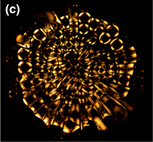Crossref Citations
This article has been cited by the following publications. This list is generated based on data provided by
Crossref.
Pal, Anusuya
Gope, Amalesh
and
Iannacchione, Germano S.
2019.
A Comparative Study of the Phase Separation of a Nematic Liquid Crystal in the Self-assembling Drying Protein Drops.
MRS Advances,
Vol. 4,
Issue. 22,
p.
1309.
Pal, Anusuya
Gope, Amalesh
and
Iannacchione, Germano S.
2019.
Pattern Recognition and Machine Intelligence.
Vol. 11941,
Issue. ,
p.
567.
Pal, Anusuya
Gope, Amalesh
Athair, Ari S.
and
Iannacchione, Germano S.
2020.
A comparative study of the drying evolution and dried morphology of two globular proteins in de-ionized water solutions.
RSC Advances,
Vol. 10,
Issue. 29,
p.
16906.
Pal, Anusuya
Gope, Amalesh
Obayemi, John D.
and
Iannacchione, Germano S.
2020.
Concentration-driven phase transition and self-assembly in drying droplets of diluting whole blood.
Scientific Reports,
Vol. 10,
Issue. 1,
Carreón, Yojana J.P.
Ríos-Ramírez, Maricarmen
Vázquez-Vergara, Pamela
Salinas-Almaguer, Samuel
Cipriano-Urbano, I.
Briones-Aranda, Alfredo
Díaz-Hernández, O.
Escalera Santos, Gerardo J.
and
González-Gutiérrez, Jorge
2021.
Effects of substrate temperature on patterns produced by dried droplets of proteins.
Colloids and Surfaces B: Biointerfaces,
Vol. 203,
Issue. ,
p.
111763.
Pal, Anusuya
Gope, Amalesh
and
Iannacchione, Germano S.
2021.
Biomedical Data Mining for Information Retrieval.
p.
213.
Carreón, Yojana J. P.
Díaz-Hernández, Orlando
Escalera Santos, Gerardo J.
Cipriano-Urbano, Ivan
Solorio-Ordaz, Francisco J.
González-Gutiérrez, Jorge
and
Zenit, Roberto
2021.
Texture Analysis of Dried Droplets for the Quality Control of Medicines.
Sensors,
Vol. 21,
Issue. 12,
p.
4048.
Pal, Anusuya
Gope, Amalesh
and
Iannacchione, Germano
2021.
Temperature and Concentration Dependence of Human Whole Blood and Protein Drying Droplets.
Biomolecules,
Vol. 11,
Issue. 2,
p.
231.
Zhang, Rongyan
Wang, Yanwei
and
Yang, Guangcan
2022.
DNA–Lysozyme Nanoarchitectonics: Quantitative Investigation on Charge Inversion and Compaction.
Polymers,
Vol. 14,
Issue. 7,
p.
1377.
Pal, Anusuya
Gope, Amalesh
and
Iannacchione, Germano S.
2022.
Hierarchical Exploration of Drying Patterns Formed in Drops Containing Lysozyme, PBS, and Liquid Crystals.
Processes,
Vol. 10,
Issue. 5,
p.
955.
Chatterjee, Atanu
Ban, Takahiko
Onizuka, Atsushi
and
Iannacchione, Germano
2022.
Pattern Formation in Thermal Convective Systems: Spatio-Temporal Thermal Statistics, Emergent Flux, and Local Equilibrium.
Journal of Non-Equilibrium Thermodynamics,
Vol. 47,
Issue. 2,
p.
123.
Pal, Anusuya
Gope, Amalesh
and
Sengupta, Anupam
2023.
Drying of bio-colloidal sessile droplets: Advances, applications, and perspectives.
Advances in Colloid and Interface Science,
Vol. 314,
Issue. ,
p.
102870.
Ancheyta-Palacios, Monserrat
Velasco-Terán, Iris G.
Carreón, Yojana J. P.
and
González-Gutiérrez, Jorge
2023.
Dried Droplets of Diluted Blood to Detect a High Concentration of Lipids.
Processes,
Vol. 11,
Issue. 7,
p.
2047.
Hidalgo, Roxana Belen Pérez
Molina-Courtois, Josías N.
Carreón, Yojana J.P.
Díaz-Hernández, Orlando
and
González-Gutiérrez, Jorge
2024.
Dried blood drops on vertical surfaces.
Colloids and Surfaces B: Biointerfaces,
Vol. 234,
Issue. ,
p.
113716.
Rathaur, Vidisha Singh
and
Panda, Siddhartha
2024.
Soluto-thermal Marangoni convection in stationary micro-bioreactors on heated substrates: Tool for in vitro diagnosis of PSA.
Biomicrofluidics,
Vol. 18,
Issue. 2,
Pal, Anusuya
Sengupta, Anupam
and
Yanagisawa, Miho
2024.
Role of motility and nutrient availability in drying patterns of algal droplets.
Scientific Reports,
Vol. 14,
Issue. 1,
Carreón, Yojana J. P.
Pereyra Zarate, Angel A.
Pérez Sánchez, Alondra E.
Díaz-Hernández, Orlando
and
González-Gutiérrez, Jorge
2024.
Surface Coating with Foliar Fertilizers.
Coatings,
Vol. 14,
Issue. 8,
p.
1007.
Pal, Anusuya
and
Yanagisawa, Miho
2024.
Pattern recognition of drying lysozyme–glucose droplets using machine learning classifiers.
Physica A: Statistical Mechanics and its Applications,
Vol. 654,
Issue. ,
p.
130141.
Pal, Anusuya
and
Gope, Amalesh
2024.
Texture identification in liquid crystal-protein droplets using evaporative drying, generalized additive modeling, and K-means Clustering.
The European Physical Journal E,
Vol. 47,
Issue. 5,
Rivera Sánchez, Luis G.
Díaz-Hernández, Orlando
Carreón, Yojana J.P.
and
González-Gutiérrez, Jorge
2024.
Pattern formation by the drying of saline droplets on pillars.
European Journal of Mechanics - B/Fluids,
Vol. 107,
Issue. ,
p.
52.


